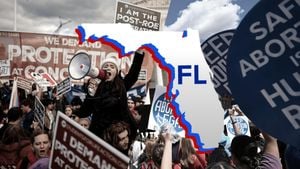Surf break protection is emerging as a powerful ally in the fight against climate change and is proving beneficial for coastal communities. Research demonstrates the potential of protecting these natural waves to not only support recreational activities but also assist with biodiversity and the carbon economy.
Jacob Bukoski, one of the study's co-authors from Oregon State University, highlighted the rising significance of conservation efforts surrounding surf breaks. "Earlier research showed surf breaks tend to be biodiversity hotspots, but no one had looked at the stocks of carbon held within these ecosystems," he noted.
According to the study published in Conservation Science & Practice, more than 88 million tonnes of irrecoverable carbon exist within the ecosystems surrounding 3,602 surf breaks globally. Irrecoverable carbon refers to carbon stored naturally, which, once lost, cannot be replaced within 30 years, making it critical for climate change mitigation.
The unique characteristics of surf breaks, typically found near coral reefs and mangrove forests, underscore their environmental importance. Bukoski emphasized, "Temperate broadleaf and mixed forests and temperate conifer forests hold nearly one-quarter of the carbon we found," highlighting key regions for conservation efforts.
Interestingly, over 17 million tonnes of the irrecoverable surf break carbon reside within areas recognized as biodiversity hotspots but lacking formal protections. This data indicates potential gaps in environmental policy and conservation status, as only 3% of surf breaks fall under some level of protection.
Climate data reveals varying densities of irrecoverable carbon, with higher concentrations closer to the equator. Exceptions include coastal forests found in the Pacific Northwest, which demonstrate the diverse ecological characteristics of these surf ecosystems.
Oregon, with its approximately 3.5 million tonnes of irrecoverable carbon, stands second among U.S. states, just behind California, which holds close to 7 million tonnes. Other states like North Carolina, Florida, and Texas also contribute significantly to the total carbon storage linked to surf breaks.
The intersection of surf tourism and carbon offset markets presents unique economic opportunities. Researchers noted the surf tourism industry is valued at around $65 billion globally, which aligns with the trading of carbon credits at approximately $10 per tonne of CO2.
Despite their manifold benefits, surf breaks face numerous threats, including coastal development and the impacts of climate change, such as rising sea levels. Bukoski stated, "When carbon-dense ecosystems are converted to other uses, they pump out large amounts of carbon dioxide,” emphasizing the consequences of neglecting these natural assets.
Conservationists advocate for heightened efforts to preserve both marine and terrestrial components of surf ecosystems to yield more benefits. Healthy coastal estuaries play pivotal roles by assisting nutrient cycling, controlling sedimentation, and acting as nurseries for young fish, outcomes mutually beneficial for the ecosystem and community.
Coral reefs, integral to the formation of surf breaks, provide recreational opportunities for divers and myriad benefits to local fishing economies. Bukoski highlighted the cultural and social value of surf break ecosystems, stating they hold considerable importance to communities worldwide, emphasizing their role beyond mere recreation.
Although irrecoverable carbon represents only a portion of the total carbon stored within surf ecosystems, it poses significant relevance for conservation priorities. Clearly, the focus should be on preserving these carbon-rich environments to combat climate change effectively.
Conservators stress the importance of strengthened protection for these climate-critical carbon stocks. Bukoski puts forth, "We should be shredding waves, not ecosystem carbon," illustrating the pressing need for more proactive measures to safeguard these unique environments.
Overall, the findings about surf breaks open up new areas of potential for not only environmentalists but local communities deeply intertwined with coastal resources. Recognizing the dynamic relationship between surfing, tourism, and ecosystem health could lead to more informed decisions about protecting coastal areas.
Through this focus on surf break conservation, there's hope for improved climate action and healthier local economies. These strategies could be part of more extensive climate mitigation efforts, showcasing surf breaks as valuable players on the environmental stage.



